Spain in the fall: 10 weekend escapes
Discover forests that turn red, stone villages, welcoming hotels and rushing rivers
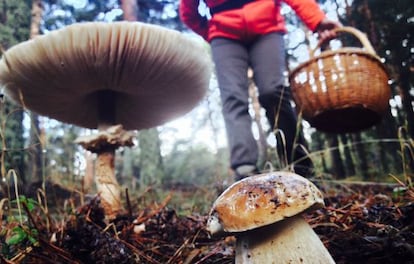
The beech forests of northern Spain are a spectacular sight as fall approaches, turning from deep green to myriad shades of gold and ochre. But other areas of the country also offer a last hurrah before winter sets in: the chestnut woodlands of Extremadura, wild mushrooms in the hills of Huelva, in western Andalusia, and herds of wild deer roaming just an hour’s drive from Madrid. The autumn rains feed rivers and waterfalls that have dried up over the long, hot summer. Meanwhile, the skies are filled with birds migrating from northern Europe to Africa. Now is the time to get out into the Spanish countryside.

01 El castañar de los Abuelos
San Martín de Trevejo (Cáceres)
Fire destroyed almost 8,000 hectares of woodland in the hills of the Sierra de Gata, in the western province of Cáceres. Fortunately, this represents around six percent of the total area, sparing forests such as Ojestos, close to the village of San Martín de Trevejo, and the largest expanse of chestnut trees in Extremadura. Using the roman road that leads up to the Santa Clara passing, it’s possible to cross this ancient forest, which in autumn is a blaze of yellow and orange. Afterwards, what better than to take a relaxing spa in the Hospedería Conventual Sierra de Gata, a former Franciscan convent dating back to the 15th century. Os Arcus, (92 751 32 04) offers dozens of varieties of mushrooms, along with local delicacies such as naranja mañega, a salad consisting of fresh orange, salt cod and boiled egg, or a stew of rice and salt cod, as well as el esparragao: left-over potatoes and cabbage fried up with paprika and bacon crackling. www.sierradegata.org
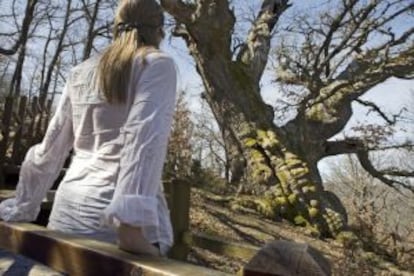
02 In search of the great oak
Cervera de Pisuerga (Palencia)
The views from the Parador de Cervera are spectacular, taking in the hills and forests of Palencia, through which runs the Pisuerga river, and dominated by the Curavacas peak, which rises to 2,520 meters. It’s worth making an early start to the day to watch the sun rise over the woods, then breakfasting in the local style on wild boar or venison sausages and heading out to walk in the forests and hills. Among the best routes is the Roblón de Estalaya, which leads up to a huge oak tree that is at least 500 years old, sitting atop the San Cristóbal hill. The 4.6-kilometer walk is well signposted, and the forest includes different species of beech, oak, and ash, along with boletus mushrooms. Peñalabra, Pacho, and the Parador’s own restaurant, all take part in a month-long festival of mushroom-based gastronomy throughout October and November. www.cerveradepisuerga.eu

03 Madrid’s “poor” hills
La Hiruela (Madrid)
Around 75 kilometers north of Madrid lies the so-called Sierra Pobre, famous for it millenarian beech forest known as the Hayedo de Montejo. But other, less-well-known woods abound in the area, such as those that surround the tiny community of La Hiruela. La senda de las Carboneras is a former charcoal burner’s trail that runs through nearby ancient oak forests, while the Molino a Molino runs alongside the Jarama river, which is lined with oaks, willows, poplars, aspen and birch trees. A good place to eat and stay the night is Casa Aldaba, which at this time of the year offers poached eggs with boletus, followed by a tart made with locally grown pear apples. www.turismolahiruela.es
04 Mushrooms worthy of Caesar
Alájar (Huelva)
The Aracena hills in Huelva province are famous for the cured ham produced from acorn-fed pigs that forage in its oak forests. But in the fall, dozens of species of mushrooms can be found here. Among the most appreciated are the Caesar’s mushroom, along with several types of boletus, among them the very rare tuntullo (similar to porcini). Contact Lynxaia for a mushroom-gathering trip through the woods, which finishes off with a mushroom-themed dinner worthy of a Roman emperor in the Posada de San Marcos, in Alájar. The hotel is run along environmentally sustainable principles, using geothermic heating and cork and sheep’s wool insulation. Much of the food is produced on site or locally. The houses in Alájar, one of the most attractive villages in the area, are decorated with geometric stone facing. The perfect plan for autumn: walk up to the Peña de Arias Montano peak, and then walk through the chestnut forests to the delightful village of Castaño de Robledo. www.alajar.net
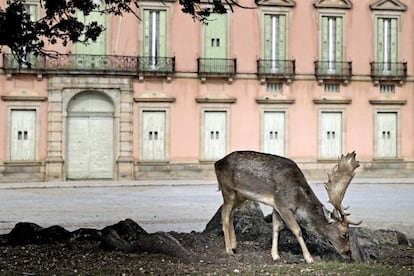
05 A royal legacy
La Granja de San Ildefonso (Segovia)
Spain’s royal family used to spend summer in the palace of La Granja to enjoy its cool evenings and mountain air, but the gardens here really come into their own in autumn, when its 70,000 trees of all species and 30 kilometers of carefully pruned hedges cover every shade of yellow and gold, through to deep bronze. Wild mushrooms can be found in the nearby pine forests of Valsaín. La Querencia de Valsaín is a small hotel and restaurant that makes the perfect base for a short stay that could take in a bike route. Just up the road is the pink-hued palace of Riofrio, surrounded by 700 hectares of woodland inhabited by fallow deer. www.patrimonionacional.es www.turismorealsitiodesanildefonso.com
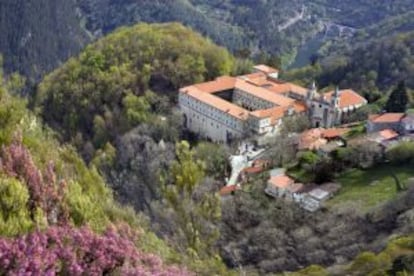
06 The taste of the forest
Santo Estevo de Ribas de Sil (Ourense)
The Ribeira Sacra (Sacred Riverbank), is a route along the Sil and Miño rivers that takes its name from the many monasteries that once flourished in this remote area. It also gives its name to one of Galicia's five wine DOs. In autumn, the steep valleys carved by the rivers are a riot of color, as the vines and chestnuts that line them change from green to gold to red. The luxurious Santo Estevo hotel is a former monastery dating back to the 11th century with a superb restaurant offering local delicacies such as scrambled eggs with roasted chestnuts. www.ribeirasacra.org
07 Hooked on boletus
Ezcaray (La Rioja)
Autumn is a busy time for the inhabitants of this small community, some of whom head out to collect boletus in the early morning, and then again at nightfall. During the last week of October and the first week of November there is a mushroom festival. Among the best places to sample local food is Casa Masip, and the Michelin-starred Portal de Echaurren. Don’t leave without buying walnuts and caparrones (a surprisingly delicate type of locally grown kidney bean) in El Colmado (Sagastía street). www.ezcaray.org
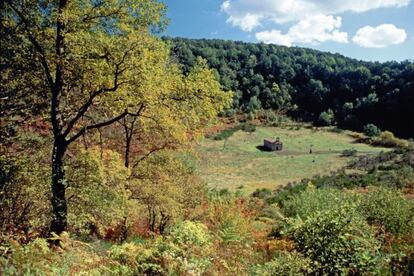
08 A forest hidden in a crater
Santa Pau (Girona)
There are any number of medieval villages in Spain, but only one, Garrotxa, sits in an extinct volcanic crater. In fact, there are more than 40 former volcanoes in the area. Close to the community of Santa Pau is an exceptional beech forest, the Fageda d’en Jordá. There are a number of routes through this protected woodland, taking in the Santa Margarida volcano, within which sits a hermitage. Mas Can Batlle is a former Catalan farmhouse that now provides top-notch accommodation and local food at a reasonable price. www.santapau.com www.turismegarrotxa.com
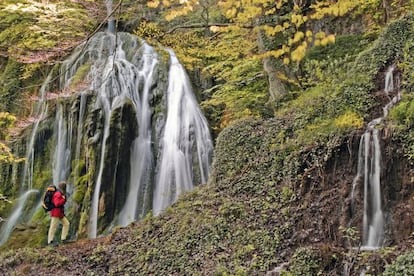
09 Goiuri Álava
A hundred-meter waterfall
Beech and oak forests, Romanic temples, and meadows filled with flocks of shaggy-haired sheep; the Oiardo river runs though picturesque landscapes in the northeast of Álava province before plunging more than 100 meters close to the village of Goiuri. Fed by the autumn rains, the rushing water is a spectacular sight, set against the backdrop of the red and gold of the forests. The spectacle can be seen from a vantage point just outside Goiuri on the A-2521 on the road to Izarra. The Nervión falls, which plummet 270 meters (the highest in Spain), are nearby. If you’re looking for something to drink, try the Baias beer produced in the village of Oiardo, and what better to accompany it than the Idiazábel cheese produced in Goiuri? Excellent accommodation can be found in the small and extremely comfortable Ugarzábel hotel, less than 100 meters from the falls. www.alavaturismo.com
10 High season in the salt marshes
Santoña (Cantabria)
A popular seaside resort that can get overcrowded in summer, and also famous for its anchovies, Santoña really comes into its own in autumn. Dozens of bird species pass by on their way to warmer climes at this time of year, while many others live in the salt marshes all year round. In October and November, the Marismas de Santoña natural park offers bird-watching trips. Down in the port area is the Restaurante de Pilar, where the fish couldn’t be fresher. The salt marshes can be visited in car by taking the CA-241, or by boat with an ornithologist, as well as on foot from the Berria beach, where the Posada Las Garzas offers sea views from its 11 rooms. www.turismosantona.es www.alavaturismo.com
Tu suscripción se está usando en otro dispositivo
¿Quieres añadir otro usuario a tu suscripción?
Si continúas leyendo en este dispositivo, no se podrá leer en el otro.
FlechaTu suscripción se está usando en otro dispositivo y solo puedes acceder a EL PAÍS desde un dispositivo a la vez.
Si quieres compartir tu cuenta, cambia tu suscripción a la modalidad Premium, así podrás añadir otro usuario. Cada uno accederá con su propia cuenta de email, lo que os permitirá personalizar vuestra experiencia en EL PAÍS.
¿Tienes una suscripción de empresa? Accede aquí para contratar más cuentas.
En el caso de no saber quién está usando tu cuenta, te recomendamos cambiar tu contraseña aquí.
Si decides continuar compartiendo tu cuenta, este mensaje se mostrará en tu dispositivo y en el de la otra persona que está usando tu cuenta de forma indefinida, afectando a tu experiencia de lectura. Puedes consultar aquí los términos y condiciones de la suscripción digital.








































